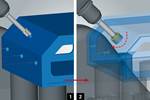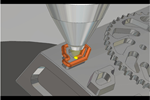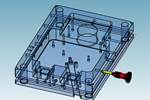Hybrid CAM Strategy Enables High-Quality, Efficient Mold Repair
As CAM technology requirements accelerate, and the market for additive/hybrid processes evolves, Open Mind highlights its hyperMILL for efficient repair or rework of molds.
As the hybrid manufacturing process — additive technologies with traditional subtractive machining — continues to expand into mainstream manufacturing, Open Mind Technologies USA, developer of the hyperMILL CAD/CAM software suite, offers its own integrated, comprehensive additive and hybrid CAM strategies. The hyperMILL programming environment enables CAD functions, additive functions and subtractive toolpath strategies that can be performed and simulated within the same system. The company notes that this holistic workflow offers clear advantages to moldmakers over a segmented approach that depends on multiple software choices that may not integrate seamlessly.
For example, mold repair is required after repeated cycles due to various wear processes. Mold repair by additive/hybrid techniques remains more cost-effective than wholesale replacement of entire molds — not only can selected features be repaired with additive manufacturing, but the additive process also enables the use of mixed materials and incorporates harder, wear-resistant materials to increase the life of the repaired mold. Repair with hybrid processes on CNC machines also provides higher quality than is achievable with manual repair processes. In this regard, Open Mind highlights the suitability of its hyperMILL CAM software.
In a use case for the thread repair of a bottle mold, start to finish, all operations were performed on a single Okuma MU8000 laser EX machine located at the Oak Ridge National Laboratory (ORNL). The first process step was to machine out the existing threads. The matching material was then deposited using a directed energy deposition (DED) laser powder system. Lastly, the form and threads were machined back into the mold.
Additional application benefits include designing intricate conformal cooling channels.
Related Content
-
Products and Services for Multiple Moldmaking Needs
New year, new technology roundup! Featured here is a collection of product offerings, from profile milling cutters to industry-specific CAD/CAM software to innovative hot work tool steels.
-
How to Supply Cooling to Additive Tooling
Additive tooling provides limitless options for cooling a mold’s difficult-to-cool areas.
-
MMT Chats: The Connection Between Additive Manufacturing Education and ROI
This MMT Chat continues the conversation with Action Mold and Machining, as two members of the Additive Manufacturing team dig a little deeper into AM education, AM’s return on investment and the facility and equipment requirements to implement AM properly.













